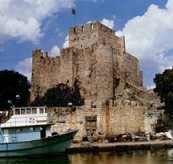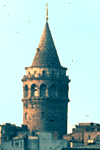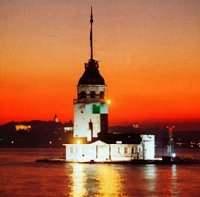Anadoluhisari
Anatolian Fortress A 14th century relic of the Ottoman Empire's first attempt to conquer Istanbul, Anatolian Fortress is located on the Asian shore of Istanbul at the narrowest point of the Bosphorus strait. The Sultan Yildirim Bayezit built this fortress in 1393 on the ruins of a Byzantine temple dedicated to Zeus. It's much smaller in size when you compare with Rumelihisari fortress lying on the European side, just on the opposite. Today, Anadoluhisari is restored and opened to visitors as an open air museum with its walls and old wooden houses around it.
A 14th century relic of the Ottoman Empire's first attempt to conquer Istanbul, Anatolian Fortress is located on the Asian shore of Istanbul at the narrowest point of the Bosphorus strait. The Sultan Yildirim Bayezit built this fortress in 1393 on the ruins of a Byzantine temple dedicated to Zeus. It's much smaller in size when you compare with Rumelihisari fortress lying on the European side, just on the opposite. Today, Anadoluhisari is restored and opened to visitors as an open air museum with its walls and old wooden houses around it.
Rumelihisari
European Fortress Sultan Mehmet the Conqueror built Rumeli Fortress in just four months in 1452 and directly opposite to Anadoluhisari fortress in preparation for the final attack on Constantinople (modern Istanbul), which led to the downfall of the Byzantine Empire. Until some years ago the fortress used to host many concerts and dramatic performances in its amphitheatre usually during the summer months. The fortress is open to the public as a museum everyday, except on Wednesdays.
Sultan Mehmet the Conqueror built Rumeli Fortress in just four months in 1452 and directly opposite to Anadoluhisari fortress in preparation for the final attack on Constantinople (modern Istanbul), which led to the downfall of the Byzantine Empire. Until some years ago the fortress used to host many concerts and dramatic performances in its amphitheatre usually during the summer months. The fortress is open to the public as a museum everyday, except on Wednesdays.
Note that Rumeli fortress is closed for restorations at the moment
Yedikule
Seven Towers dungeonsThis seven towered fortress was built in the time of Sultan Fatih Mehmet to protect the treasury. During Murat III's reign, the treasury protected at Yedikule was relocated to the Topkapi Palace and Yedikule began to be used as a dungeon. The place of imprisonment of many foreign ambassadors and Ottoman statesman, as well as a place of execution for some, the fortress was last used as a prison in 1831. It then became a dwelling for the lions of Topkapi Palace, and later gunpowder manufacturing place. Today, the fortress is recently restored and re-opened to public, and also used to host open air concerts in its inner courtyard during the summer months.
Galata Kulesi
Galata Tower A 55 meter tower providing a panoramic view of the old town, Galata Kulesi was built in the 14th century by the Genoese as part of the defense wall surrounding their district of Galata directly opposite Byzantium (Constantinopolis). The Genoese used to trade with the Byzantines and the tower was used for the surveillance of the Harbor in the Golden Horn. After the conquest of Constantinople by Ottoman sultan Mehmet II, it served to detect fires in the city. Today, there is an elevator but there are still three more floors to climb by the stairs to get on the 360 panoramic terrace. It's open from early morning until late afternoon everyday.
A 55 meter tower providing a panoramic view of the old town, Galata Kulesi was built in the 14th century by the Genoese as part of the defense wall surrounding their district of Galata directly opposite Byzantium (Constantinopolis). The Genoese used to trade with the Byzantines and the tower was used for the surveillance of the Harbor in the Golden Horn. After the conquest of Constantinople by Ottoman sultan Mehmet II, it served to detect fires in the city. Today, there is an elevator but there are still three more floors to climb by the stairs to get on the 360 panoramic terrace. It's open from early morning until late afternoon everyday.
Kiz Kulesi
Leander's Tower - Maiden Tower Kiz Kulesi is a 12th century stone tower erected on a rock at the entrance of the Bosphorus strait by the Byzantine Emperor Manuel Komnenos. The tower, which has served as a prison and a lighthouse in the past, became the source of many legends in ancient days, such as Leander's or Maiden's. It was renovated and re-opened to public in May 2023. Transportation to the Tower is made by shuttle boats from both shores of the Bosphorus at certain times of the day.
Kiz Kulesi is a 12th century stone tower erected on a rock at the entrance of the Bosphorus strait by the Byzantine Emperor Manuel Komnenos. The tower, which has served as a prison and a lighthouse in the past, became the source of many legends in ancient days, such as Leander's or Maiden's. It was renovated and re-opened to public in May 2023. Transportation to the Tower is made by shuttle boats from both shores of the Bosphorus at certain times of the day.
Beyazit Kulesi
Fire Tower Beyazit Tower was built by architect Senekerim Kalfa of the Balyan family in 1828 under the reign of sultan Mahmud II. The tower is 85 meters in height and has four floors, 180 steps staircase to the top. It was built overlooking the Golden Horn for the purpose of detecting fires in Istanbul; baskets during the day and large red, green and white lanterns in the evenings were hung on the tower to indicate that there was a fire in the city. Today, the tower indicates the next day's weather in Istanbul by changing lights; blue means nice weather, green means rain, yellow means fog, and red means snow. The tower is recently restored but unfortunately it's still closed to the public at the moment, and stands in the grounds of University of Istanbul.
Beyazit Tower was built by architect Senekerim Kalfa of the Balyan family in 1828 under the reign of sultan Mahmud II. The tower is 85 meters in height and has four floors, 180 steps staircase to the top. It was built overlooking the Golden Horn for the purpose of detecting fires in Istanbul; baskets during the day and large red, green and white lanterns in the evenings were hung on the tower to indicate that there was a fire in the city. Today, the tower indicates the next day's weather in Istanbul by changing lights; blue means nice weather, green means rain, yellow means fog, and red means snow. The tower is recently restored but unfortunately it's still closed to the public at the moment, and stands in the grounds of University of Istanbul.
Dikilitas
Egyptian Obelisk The Obelisk was originally erected in the 16th century BC by the Pharaoh Thutmosis III in honor of the God of Sun Amon Ra in the city of Teb, Egypt, in front of the temple of Luxor. Brought to Istanbul by emperor Theodosius I in 390 AD for the decoration of the ancient Hippodrome. The approximately 19 meter high obelisk is covered on all four sides with hieroglyphic pictograms and stands on a marble base with many friezes depicting the Emperor and his family in the Hippodrome. After decoding the hieroglyphs it has been discovered that last 5 or 6 meters of the Obelisk is missing from the bottom, probably was broken during the transportation.
The Obelisk was originally erected in the 16th century BC by the Pharaoh Thutmosis III in honor of the God of Sun Amon Ra in the city of Teb, Egypt, in front of the temple of Luxor. Brought to Istanbul by emperor Theodosius I in 390 AD for the decoration of the ancient Hippodrome. The approximately 19 meter high obelisk is covered on all four sides with hieroglyphic pictograms and stands on a marble base with many friezes depicting the Emperor and his family in the Hippodrome. After decoding the hieroglyphs it has been discovered that last 5 or 6 meters of the Obelisk is missing from the bottom, probably was broken during the transportation.
Stone Obelisk
Orme SutunThe Stone Obelisk column was erected by Constantine VII, known also as Porphyrogenetus, around 944 AD for the decoration of the Byzantine Hippodrome. It was made of limestone blocks and completely covered with bronze slabs bearing inscriptions which were dedications made to his grand father Basileus I. Unfortunately all bronze slabs were removed during the rule of the 4th Crusade who melted them to make coins and weapons, therefore none of them survived until our days. The column is about 32 meters high and rests on a small marble base.
Serpentine Column
Burmali SutunOriginally this column was erected in 479 BC in front of Temple of Apollo in Delphi, Greece, to commemorate the naval victory of the Greeks over the Persians and to show their respect to Apollo for winning the battle after consulting his oracle. The bronze column was formed by 3 intertwined snakes and names of the 31 Greek city-states that participated in the war were written on them. It's also said that there was a big golden pot on top of the snake heads. The column was brought to Constantinople in the 4th century AD by emperor Constantine I, for the decoration of the Hippodrome. The Serpentine column was originally 8 meters high but today only 5.30 meters left because nobody enjoyed this statue here being the snakes representation of the devil, so everybody took a piece off to destroy it. Therefore, the 3 snake heads were also destroyed and only pieces of one of the heads is found during the excavations and it was taken to the Archaeological Museum of Istanbul.
Goths' Column
Gotlar SutunuThe Goths column stands at the outer courtyard of Topkapi Palace, in Gulhane Park, and surrounded by trees. It's one of the oldest columns from the Roman period, which was erected probably in the 3rd or 4th centuries AD, carved from a single piece of stone and decorated with a Corinth style capital containing an eagle relief. Because of the inscriptions mentioning the victory over the Goths, it's called as Goths Column. The column is 15 meters high and rests on a small base.
Cemberlitas Column
Constantine's ColumnThe column, known as Cemberlitas (column with rings) in Turkish, was brought to Constantinople from the Temple of Apollo by emperor Constantinus I between 325 - 328 AD. There was a statue of Apollo on top which was replaced by a cross during Christianity. The column symbolizes also the end of Pagan tradition on the Byzantine lands. It was erected in the middle of an oval square known as Forum Constantini, located on the second hill of the city. The cross was removed after the Conquest of Constantinople during the Ottoman period. The 35 meter high column was damaged by big fires and weather conditions during the ages so Sultan Mustafa II re-enforced the column with iron rings. The marble capital is from the 12th century and the reinforcing pedestal from the 18th.
Kiztasi Column
Marcianus ColumnThe Kiztasi column was erected around 450 AD and dedicated to the Byzantine Emperor Marcianus. It's made of 17 meter-high granite and rests on a marble base. The Corinthian style base is decorated with a relief depicting angels (or victory goddess) therefore it was called "Kiz Tasi" by the local people, meaning "Maiden's Stone" in Turkish. Today the column stands in Fatih district.
Arcadios Column
The column is located at Cerrahpasa neighborhood. It was erected in the 5th century AD by emperor Theodosius I and dedicated to Arcadios with a statue on top. According to old sources and travelers, the column was about 50 meters high and decorated with friezes describing victories against Barbarians, but today only the pedestal remains. The column was badly damaged during the earthquakes and it was strengthen by banding metal rings during the Ottoman period.
Theodosius Triumphal Arch
Theodosius I erected a huge Triumphal Arch which was crowned with the statue of the emperor and a column in the center of old Forum Tauri (today's Beyazit Square) in the 4th century AD. Some marble pieces of the Arch can still be seen today in its original location but the column and monumental fountain were destroyed by an earthquake in 557 and completely vanished around 16th century being used as construction material. Some of the pieces were used in the construction of a Turkish Bath next door, of which friezes can still be noticed today on its walls and base.
Million Stone
It's located at Sultanahmet neighborhood, in the center of old city. The Million Stone was always put in the center of the city and distances to all corners of the Byzantine Empire were once measured starting from this point. The stone was erected under the reign of Constantine the Great around 4th century AD in the northeastern corner of Augusteion Square, marking the starting point of an extensive road network.
Aqueduct of Valens
Bozdogan KemeriThis is a Late Roman and Early Byzantine period aqueduct built probably around 4th century AD connecting two hills (out of seven) of ancient Constantinople over this little valley. It's known as the Aqueduct of Valens, and today local people call it as Bozdogan Kemeri (Arch) in Turkish. Originally it was used to bring water to Istanbul from the springs of Belgrade forest, about 30 km north of the city.
During the late Byzantine period it wasn't used much and fell into ruins, then restored by the Ottomans after the Conquest of the city and served for some time to carry water again. Over the centuries, it was badly damaged because of disuse and roads and buildings constructed on and around it. Today only bits and pieces left from the original aqueducts on its way from the forest to the city center, and in Sarachane neighborhood there is a 900 meter long part of it, namely Bozdogan arch. The Municipality of Istanbul started the restorations in 1998.
Tower of Justice
Kasr-i AdlThe Tower of Justice is a part of Topkapi Palace and stands in its second courtyard, right above Council Chamber next to the Harem complex. It was built under the reign of Sultan Mehmet II and used as a watch tower and surveillance of the Golden Horn. Several restorations were made to the tower and the last one was made by the architect Sarkis Balyan. The name of the tower comes from the Divan Room (Council Chamber), where there was a small window on the wall from which the sultan himself (or his spy) used to listen the Viziers behind a curtain and if he didn't like any thoughts then ordered to kill or imprison that member of the Council, so this was of course the justice of the sultan.
Dolmabahce Clock Tower
The Clock Tower was built right after Dolmabahce Palace by Sultan Abdulhamid II between 1890 - 1895, at the entryway of the Palace. The architect was Sarkis Balyan again, the imperial architect. The clock has a European design and is 27 meter high with four floors, and on two sides the Tugra (monogram) of the sultan can be noticed. The Paul Garnier Clock was installed by master clockmaker Johann Meyar and its mechanism was partially equipped with electronics in 1979. The clock tower is recently restored hence its clock is perfectly functioning.
Etfal Hospital Clock Tower
The Clock Tower was built by Sultan Abdulhamid II in the 19th century in the grounds of Hamidiye Etfal Hospital (Sisli Etfal Hospital today). The architect was Mehmed Sukru Bey. It was made of marble and local stones, has an height of 20 meters, and the Tugra (monohram) of the Sultan Abdulhamid II can be seen in the front.
Yildiz Clock Tower
The clock Tower was built in 1890 by Sultan Abdulhamid II in the courtyard of the Yildiz Hamidiye Mosque. It has an octagonal shape with three floors. The first floor has four separate inscriptions, the second floor contains a thermometer and a barometer, the top floor is a clock room, and there is a compass rose on the roof. The clock was repaired in 1993.
Nusretiye Clock Tower
The Clock Tower was built in neo-classical style by Sultan Abdulmecid next to the Nusretiye Mosque, at Tophane neighborhood. The tower is 15 meters high and contains the Tugra (monogram) of the sultan on the entrance. Unfortunately today the Clock Tower is in bad conditions and the original clock and its mechanism couldn't survive until our days.

